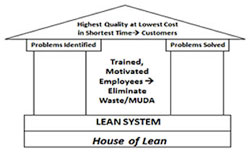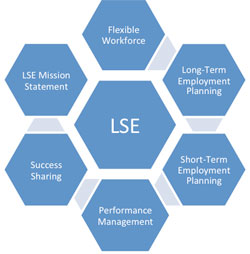
Lean Sustainable Employment (LSE) is the key to unlocking loyalty and innovation in your workforce.
Lean is a system that requires employees who are trained and motivated to do the work and improve the work. In the best lean companies, employees believe it is their job to do their assigned work and identify and solve problems that they encounter.
Trained, motivated employees who consider it part of their regular job to eliminate waste are the essence of the lean system, as the House of Lean diagram illustrates below:

In an earlier Target Online article about capturing the “hearts and minds” of front-line employees, I described the “3 Ls of Lean” — leadership, learning and listening. Now I want to add one more “L”, and that is LSE.
LSE is a disciplined, multi-faceted approach that is more than job security and more than employment planning. LSE is the way you can create an environment where your employees will be committed to eliminating waste even if their efforts would appear to threaten their jobs or overtime in the short-term. LSE puts your employment philosophy on par with your sales, operating and profit philosophies so that it is lean and sustainable for the long-term.
Some fundamental elements of LSE (see diagram) include the following:
-
A flexible, trained lean workforce that is based on teams and has the bare minimum of job classifications. This workforce should be thoroughly cross-trained and regularly rotated among the various jobs in your operations. A key ingredient to this workforce should be team leaders who are ready and willing to jump in and “do the work” when conditions warrant.
-
A long-term and short-term employment planning process that puts a real premium on hiring full-time regular employees (remember they must be sustainable). The plans should integrate and balance the sales and production scheduling across the company. The long-term plans should go out three to five years and be revised annually and/or when volume forecasts change significantly.
The short-term plans should be done monthly and fine-tuned weekly. The plans should incorporate temporary employees, part-time workers, team leaders on-line and OT to handle production fluctuations, kaizen training and lean workouts.
-
Performance management and success sharing are two essential elements to LSE because they highlight the core notions that everyone is accountable and all employees share in the prosperity of the organization.
Performance management needs to focus on both doing the work and improving the work. Employees at the best lean organizations are accountable for doing both on a constant basis.
 Success sharing can take many forms from profit sharing to gain sharing, etc. The key, though, is that all employees believe that they share in the financial success of the organization to the point where it is an important and anticipated part of their total compensation. Success sharing results need to be prominently displayed for every employee to see and be motivated by every shift.
Success sharing can take many forms from profit sharing to gain sharing, etc. The key, though, is that all employees believe that they share in the financial success of the organization to the point where it is an important and anticipated part of their total compensation. Success sharing results need to be prominently displayed for every employee to see and be motivated by every shift.
- Finally, after and only after the first three elements are in place, issue a clearly communicated LSE mission statement that it is the organization’s goal to develop and sustain its workforce through the “ups and downs” of your business and industry — and, actually, most ups and downs are predictable and short term. Then, do it.
Lean doesn’t work unless your employees buy-in at the gut level and that means they have to trust that the organization is looking out for them and their long-term well-being. A promising lean organization starts with “what’s in it for me” and progresses to “we are in this together and I better do my part to make it better.”
If you want lean to work for your organization, you need to engage your employees in a trusting, reciprocal relationship: LSE gives you the best chance of doing that!
Mark S. Doman is a Pawley Professor in Lean Studies at Oakland University in the newly formed Department of Organizational Leadership. Prior to joining Oakland University, he had 25 years of business experience with Ford and AT&T, where he held various executive positions in operations, human resources and legal. He has led several major organizational change initiatives throughout his career that included corporate restructuring, lean workouts and process re-engineering. He is the author of A New Lean Paradigm in Higher Education: A Case Study. Quality Assurance in Education, Vol. 19 No. 3, 2011, “How Lean Ready Are You?” Target, Vol. 28 No. 2, 2012 and “The Beginner’s Guide to Lean” series. His email address is doman@oakland.edu.


